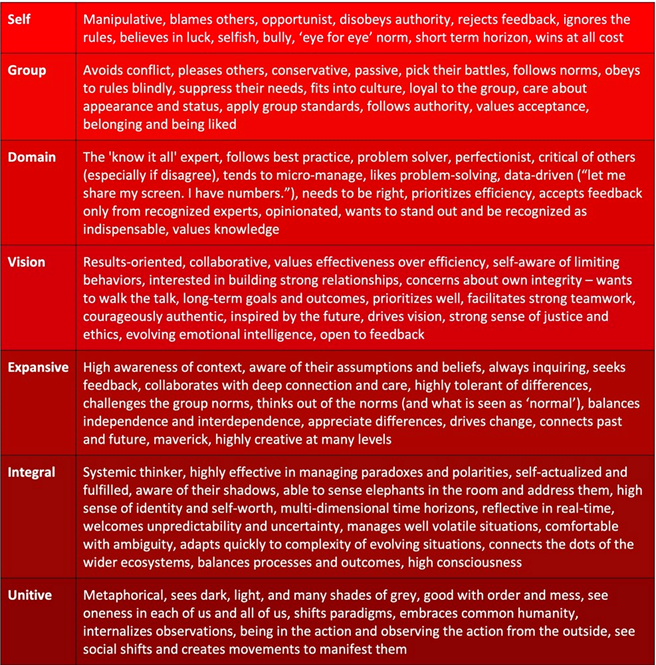3D thinking
- Dave Osh

- Feb 22, 2023
- 3 min read

CEOs struggle to resolve conflicts in which executives have different perspectives they can't unite into one because they lack a 3-D perspective.
Why It Matters: When we don't see the 3-D perspective of what’s true, we are stuck or make bad decisions.
The Big Picture: In a recent survey I did with 107 CEOs, alignment within the exec team came as the top issue.
The way I see it, the lack of 3-D, 4-D, and 5-D thinking capability contributes to the misalignment challenges.
This article covers 3-D thinking, and the next two cover 4-D and 5-D thinking in this 3-part series.
3-D thinking is not a technical skill we can easily learn. It’s an adaptive capacity to interpret reality in a more complex way.
“The single biggest failure of leadership is to treat adaptive challenges like technical problems.” - Ronald Heifetz, Harvard Professor
Adaptive challenges require changes in values, beliefs, mindsets, relationships, and approaches to work. They aren’t playbook-made solutions.
Adaptive challenges require changing multiple domains. It isn’t one thing.
Adaptive challenges don’t have a solution. They require experiments and new discoveries. They are not just a matter of decision-making.
3-D thinking is an adaptive challenge that depends on our level of potential. The more expansive the potential is, the higher the capacity to think in 3-D.
The Centric levels have none to limited 3-D thinking.
The Transformer levels have higher 3-D thinking.
1D thinking
Self-Centric and Group Centric potentials can see only one perspective: their perspective.
Self-centric people impose their 1-D thinking on everybody else. They aren’t capable of listening or even considering other points of view.
Group Centric listens and accepts the group's point of view almost blindly, especially from authority power. They will automatically reject other groups' perspectives. It's ‘us vs. them.’
1-D thinking is a 1st person's perspective - subjective to the person's mindset.
2D thinking
Domain Centric and Vision Centric potentials can see, relate, and acknowledge other perspectives with some preconditions.
Domain Centric considers or adopts other perspectives if they come from people who are more experts than them.
Vision Centric welcomes other points of view as long as they fit into their pre-conceived goals and outcomes.
2-D thinking is a 2nd person's perspective - able to see the other's perspective.
3D thinking
Expansive, Integral, and Unitive Transformer potentials can look at a situation from all aspects in the context of the system they operate.
Expansive Transformer asks questions with deep curiosity that expand their view from 1-D to 2-D to 3-D thinking.
Integral Transformer demonstrates 4-D thinking, and Unitive Transformer 5-D thinking, which we'll cover in future articles.
How to develop 3-D thinking
Here are a few hacks to help you evolve your potential while you're working on boosting your potential:
Pause to ask yourself and others, “How can I/we be wrong?”
Invite the silent voices into the conversation, which usually don't speak up. They may see perspectives the loudest leaders missed
Let go of driving the conversation. Let other people take over, so you can change your frame of mind
Scan your body for your feelings, take a deep breath, center yourself, and observe the situation from different angles
Slow down to reflect and challenge the way you’re thinking. “What are other possible interpretations?”
Ask, "If I'm the system, what would I see?"
Backstory
One of the most adaptive challenges I faced as a young fighter pilot after the flight academy was multi-jet air-to-air combat. The 3-D aspects of that challenge were beyond my capacity on some occasions.
Imagine two jets climbing vertically, and one is rolling during the ascend. The pilot of the rolling jet sees the other jet on the right, above, and left sides and loses eye contact in the blind spot below, although they are both ascending vertically.

Now, imagine four jets maneuvering rapidly in all directions and changing positions rapidly. It's very difficult to maintain 3-D thinking in such chaos.
In these situations, the pilots who 'have the big picture’ temporarily take over leadership from the leader. They don’t ask permission and don’t wait to be granted it.
At the same time, the pilots communicate on the radio and share their ‘perspectives’ so that the team can ‘build’ the combat 3-D picture.
The bottom line: Like fighter pilots who learn the 3-D picture through collaborative communication, leaders can complement their points of view from what their fellow leaders see until they have the full 3-D picture.






Comments